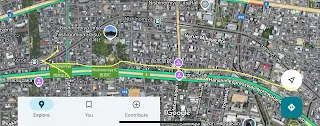Entering a Sake Giant of Japan: 西宮宿(Nishinomiya inn town)
For most Japanese, Nishinomiya city is known for Koshien baseball stadium, “the Mecca of high school baseball championships” and the home stadium of a Nippon Professional Baseball team, Hanshin Tigers.
Here is the overview of Nishinomiya inn town of Saigoku Kaido. And I am going to warn you. If you are looking for series of nice old houses to show “Good Old Japan”, for over the next several inn towns, go somewhere else. However, Nishinomiya has something to offer you. And I am saving something good for the last. Let’s go!
Coming down from north, along Higashi River, on the right(on the left of the map), there is an ancient temple, Kaiseiji, established in 1394. It’s a Rinzai school of Zen Buddhist temple.
At this intersection, Saigoku Kaido takes sharp 90-degree curve. At the corner, there is Shonenji temple. According to online research, it is a Jodo-Shinshu Pure Land Buddhism temple, otherwise I could not find any good info like history about this temple. If anybody knows about this temple, leave me on the comment section please.
Sometimes I found the street sign that says 旧国道(Kyu-Kokudo: old national route). This means that the route used to be a national route. National routes have been built after old routes like Tokaido, Saigoku Kaido and so on. And thus is the area of Nishinomiya Saigoku Kaido inn town.
Throughout Nishinomiya inn town area, I did not find any single old house that looked like the one in Edo to early Meiji period(1600-1900s).
Nishinomiya shrine is certainly a really ancient shrine, dating possibly back to at least 12th century or further. Throughout this region, there are so many ancient shrines and temples. Check out Nishinomiya city tourism association’s website.
This old sake brewery building is a bar now. The white building on the right is Hakutaka brewery.
The brick building is a museum and the restaurant, Nihonsakari Rengakan. Apparently the building has been registered as a Japan Heritage. This is a part of Nihonsakari brewery.
To Nishinomiya inn town area, the closest train station is Hanshin railways Nishinomiya station. Hanshin Koroen station and JR Sakura-Shikugawa station are not too far from Nishinomiya inn town area.
References:
Japan Heritage: Itami Morohaku and Nada no Ki-Ippon. Hanshinkan Japan Heritage Promotional Council Office. https://itami-nadagogo.com/public/en (Accessed in 5/6/2025)
Kaiseiji. Nishinomiya Magazine. Rex Incorporated. https://nishimag.com/trip/spot/4911/ (Japanese only: accessed in 5/6/2025)
“Miyamizu”, Nishinomiya’s Sake Brewing Water. Hakushika Memorial Museum of Sake. https://sake-museum.jp/en/saketalk/537/ (Accessed in 5/6/2025)
Nishinomiya Tourism Association official website. https://nishinomiya-kanko.jp/english/index.html (Accessed in 5/6/2025)
Saigoku Kaido guide map. Rekishi Kaido Promotional Council. (The original title: 西国街道みちしるべ 歴史街道推進協議会) https://www.rekishikaido.gr.jp/aruku/saigoku/ (Accessed in 5/6/2025)












Comments
Post a Comment